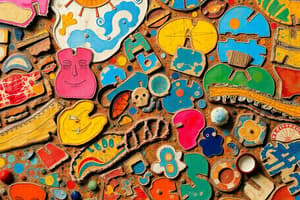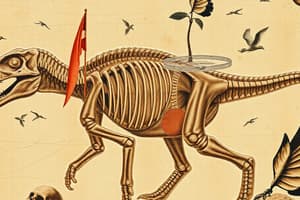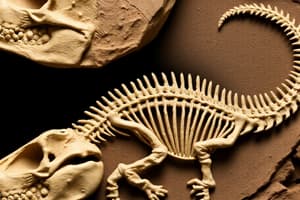Podcast
Questions and Answers
What does the term 'taphonomy' refer to?
What does the term 'taphonomy' refer to?
- The study of living organisms and their habitats
- The chemical processes of fossilization
- The study of microbial life in sediments
- The processes involved in an organism becoming a fossil (correct)
Which factor does NOT influence fossilization potential?
Which factor does NOT influence fossilization potential?
- Surrounding environmental conditions
- The presence of predators (correct)
- Composition of the organism's remains
- Accessibility to scavengers
Which of the following is NOT a recommended condition for dying to increase chances of fossilization?
Which of the following is NOT a recommended condition for dying to increase chances of fossilization?
- Dying in a high-temperature environment (correct)
- Undergoing necrolysis before burial
- Experiencing fast dehydration
- Being buried in low pH sediments
Which of the following processes is involved in the loss of soft tissue during fossilization?
Which of the following processes is involved in the loss of soft tissue during fossilization?
What must occur after death but before burial to enhance fossilization potential?
What must occur after death but before burial to enhance fossilization potential?
What process occurs in anaerobic environments that eliminates hydrogen and oxygen while leaving pure carbon behind?
What process occurs in anaerobic environments that eliminates hydrogen and oxygen while leaving pure carbon behind?
Which of the following conditions can slow down the degradation of corpses and vegetal remains?
Which of the following conditions can slow down the degradation of corpses and vegetal remains?
What is the term for the process where minerals fill the pores of bones or shells?
What is the term for the process where minerals fill the pores of bones or shells?
What mechanical effect can cause vertebrae and ribs to be transported farther than teeth during decay?
What mechanical effect can cause vertebrae and ribs to be transported farther than teeth during decay?
Which of the following processes can lead to the preservation of skeletal microstructures?
Which of the following processes can lead to the preservation of skeletal microstructures?
In which of the following environments is moisture considered important for preservation?
In which of the following environments is moisture considered important for preservation?
Which factor is critical for the oriented deposition of remains due to natural forces?
Which factor is critical for the oriented deposition of remains due to natural forces?
What type of recrystallization involves aragonite reverting to calcite?
What type of recrystallization involves aragonite reverting to calcite?
Flashcards
Taphonomy
Taphonomy
The study of how organisms become fossils and the processes involved in their preservation within Earth's strata.
Fossilization
Fossilization
The transformation of an organism's remains into a fossil, requiring specific conditions to occur.
Taphonomic Filters
Taphonomic Filters
Factors that influence the probability of an organism becoming a fossil, including its composition, environment, and interactions with other organisms.
Necrolysis
Necrolysis
Signup and view all the flashcards
Environment's Impact on Fossilization
Environment's Impact on Fossilization
Signup and view all the flashcards
Diagenesis
Diagenesis
Signup and view all the flashcards
Replacement
Replacement
Signup and view all the flashcards
Permineralization
Permineralization
Signup and view all the flashcards
Permineralization of bones
Permineralization of bones
Signup and view all the flashcards
Recrystallization
Recrystallization
Signup and view all the flashcards
Neomorphism
Neomorphism
Signup and view all the flashcards
Fossil formation
Fossil formation
Signup and view all the flashcards
Study Notes
Taphonomy
- Taphonomy is the study of what happens to an organism after death, focusing on how it becomes a fossil.
- It studies the processes organisms undergo as they become incorporated into the sedimentary record.
- The number of fossils is significantly less compared to the number of organisms that have ever lived.
- Fossilization potential depends on composition (organic/inorganic) and surrounding environment.
Becoming a Fossil
- To become a fossil, an organism must die.
- It's then subject to various processes, including diseases, natural disasters, predation, and decomposition.
- The organism's non-mineralized parts must break down.
- Ideally, the organism dies in an environment with ideal conditions for preservation.
- Factors like temperature, freezing, dehydration, and the presence of oxygen and microbes influence the rate and type of decomposition.
Transport Agents
- After death, corpses and plant matter are subjected to transport agents (rivers, waves, hurricanes), potentially degrading them and moving them to new locations.
- Mechanical (abrasion, crushing), chemical (corrosion), and other factors influence the potential for transport and degradation.
Burial
- Burial is a critical step in fossilization, potentially preserving remains.
- Burial can occur in organic debris or bogs which can lead to exceptional preservation.
Direct Fossilization
- Recrystallization: crystalline structures in fossils can increase in size without changing the mineral composition.
- Important microstructures can be preserved if the crystallizing process doesn't destroy them.
- Neomorphism: a type of recrystallization where Aragonite converts into Calcite, destroying original microstructures.
Indirect Fossilization
- External molds: an empty space created where the original shell or body part has been dissolved and filled with sediment and minerals.
- External casts: molds that are filled with minerals leading to a replica of the original.
- Internal molds/casts: formed after the body part or shell is dissolved leaving an internal mold.
- Composite molds: formed when multiple processes create molds within each other.
Unaltered Preservation
- Preservation of remains in impermeable sediments or materials, without alteration.
Studying That Suits You
Use AI to generate personalized quizzes and flashcards to suit your learning preferences.
Related Documents
Description
Explore the fascinating field of taphonomy, which examines the processes organisms undergo after death and their journey to fossilization. Understand the crucial factors that influence fossil preservation and the role of transport agents in shaping the sedimentary record. This quiz delves into the science behind how life transforms into fossil, highlighting both environmental impacts and biological processes.




